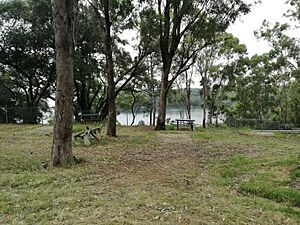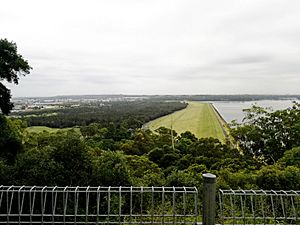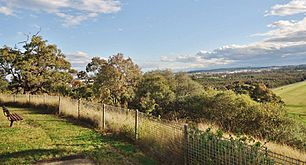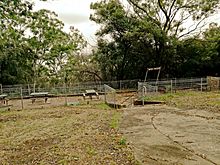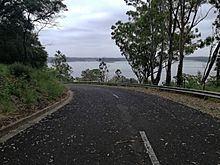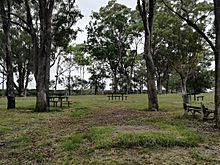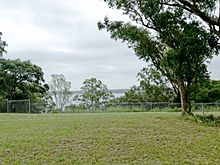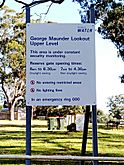Prospect Nature Reserve facts for kids
Quick facts for kids Prospect Nature ReserveNew South Wales |
|
|---|---|
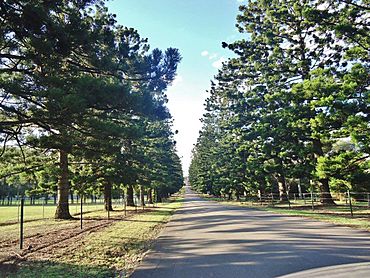
Entrance to the reserve from William Lawson Drive
|
|
| Nearest town or city | Prospect |
| Established | 2007 |
| Area | 3.253 km2 (1.3 sq mi) |
| Managing authorities | Blacktown City Council |
Prospect Nature Reserve is a special natural area in Sydney, New South Wales, Australia. It's located in the western suburbs, right next to Prospect Reservoir. This reserve is a great place for families and friends to enjoy nature.
You can find picnic spots, amazing views, walking trails, and BBQ areas here. It's all part of the beautiful Australian bush. The reserve is open to everyone and is looked after by Sydney Water.
It's also part of a "Special Water Catchment" area, which means it helps protect our water supply. The New South Wales National Parks and Wildlife Service helps manage it. The reserve is mostly on the northern and eastern sides of Prospect Reservoir. It's in the Blacktown City Council area, but it's also close to Cumberland City Council and the City of Fairfield. You can find Prospect Nature Reserve inside the larger Western Sydney Parklands.
The reserve was created on February 28, 2007. It covers a large area of 325.3 hectares (about 800 acres). It's about 10 kilometers west of Parramatta and 5 kilometers south of Blacktown. This reserve is very important because it protects one of the biggest remaining parts of the Cumberland Plain Woodland. This type of forest is critically endangered, so the reserve plays a big role in saving plants and animals in Western Sydney. The land also has cultural importance to the Darug people.
Contents
Exploring the Reserve's Nature
Amazing Plants and Trees
Prospect Nature Reserve is home to some amazing plants. It has parts of the Cumberland Plain Woodland, which used to cover a lot of Western Sydney. This reserve has the biggest area of Grey Box Woodland in the Blacktown area. This includes both the Shale Plains Woodland and Shale Hills Woodland types of the Cumberland Plain.
You can also find other cool trees like Forest Red Gum (Eucalyptus tereticornis) and Spotted Gum (Corymbia maculata). There are also smaller plants like Blackthorn (Bursaria spinosa), Native Indigo (Indigofera australis), and Dodonaea viscosa. At the entrance to the reserve, you'll see tall Hoop pines.
The bushland is in the best condition in the northern part of the reserve. A quick study of the plants near Prospect Reservoir found over fifty native species! About two-thirds of the reserve's plants are Shale Hills Woodland, and the rest is Shale Plains Woodland.
Near the reservoir's edge, you'll find wetlands with reeds and rushes. These areas have formed since the reservoir was filled with water. Some parts of the bushland have fewer types of native plants and more weeds. These weeds include Chloris gayana (Rhodes grass) and Eragrostis curvula (African love grass).
Pesky Weeds and Invasive Plants
Unfortunately, some unwanted plants, called invasive species, have made their way into the reserve. These include African olive (Olea europaea subsp. Africana), Moth plant (Araujia hortorum), and Lantana (Lantana camara). These weeds can harm the native plants by taking over their space and resources.
Less than 13% of the original Cumberland Plain Woodland is left. A lot of what's left is damaged by weeds, rubbish, illegal vehicles, and animals eating too much. But in the protected areas of the reserve, these problems are mostly gone. This helps the bushland stay in excellent condition.
Wonderful Wildlife
Prospect Nature Reserve is a safe haven for many animals in Western Sydney. You might spot mammals like wombats, echidnas, and eastern grey kangaroos. More than 12 types of bats, including some endangered ones, have been seen near the reservoir.
Other animals living here include:
- Squirrel Glider (Petaurus norfolcensis)
- Green and Golden Bell Frog (Litoria aurea)
- Grey-headed Flying Fox (Pteropus poliocephalus)
- Different types of bats like Myotis macropus, Mormopterus norfolkensis, Falsistrellus tasmaniensis, and Scoteanax rueppellii.
- Birds such as Swift Parrot (Lathamus discolor), Little Eagle (Hieraaetus morphnoides), Australian Masked Owl (Tyto novaehollandiae), and Daphoenositta chrysoptera.
Some introduced animals that are not native to Australia also live here. These include rabbits, foxes, feral cats, and European hares.
Understanding the Land's Geology
The land in the reserve is mostly made of a type of rock called Wianamatta Shale. This rock greatly affects the soil and the plants that grow here. The soils are usually shallow to medium deep. You'll find red and brown soils on the higher parts and yellow soils on lower slopes.
On the western side of George Maunder Lookout, there's a special rock formation called the Prospect dolerite intrusion. This is Sydney's largest area of igneous rock, which means it formed from cooled magma (molten rock). It was created millions of years ago, during the Early Jurassic period, after volcanic activity. Hot fluids moved through the rock, leaving behind minerals like prehnite and calcite.
The hill you see at George Maunder Lookout is actually what's left of this ancient volcanic core. Over millions of years, wind and rain wore it down to the small hill it is today, standing out in the mostly flat lands of Western Sydney.
Fun Parks and Picnic Spots
The reserve has several great park areas where you can have picnics and BBQs. They are located along the eastern side of Prospect Reservoir, from north to south:
- Andrew Campbell Reserve: This park is right at the northern entrance of the reservoir. It has beautiful native trees and a dry forest nearby. You'll find parking and a playground for kids here. This area was closed for renovations but is expected to reopen.
- George Maunder Park: This section is right next to the reservoir, offering amazing views. It has a big grassy field with eucalyptus and palm trees. The Prospect Reservoir Valve House, an important building for the reservoir, is located here.
To the west, there's a steep hill called George Maunder Lookout. This lookout is part of Prospect Hill. It has two levels that offer clear views of the reservoir and the Blue Mountains in the distance. Both levels have lots of picnic tables, toilets, and water access.
The upper lookout area was closed for a while due to construction nearby. Both lookout areas were closed in 2009. After being left empty for over ten years, the George Maunder lookouts finally reopened in mid-2019 after a big renovation. They replaced damaged tables, added new BBQs, new signs, and fixed the toilets. The lower lookout is about 85 meters (279 feet) above sea level, and the upper area is about 110 meters (361 feet) high.
- Walder Park: This park is in the southernmost part of the reserve. It's close to the reservoir but set back a bit, so it doesn't have direct views. It has picnic seats and a car park.
How to Get There
You can reach Prospect Nature Reserve by driving on William Lawson Drive. This road connects to Reservoir Road, which you can get to from the Western Motorway (from the north) or Prospect Highway (from the southeast).
The reserve is about 10 kilometers (6 miles) west of Parramatta and 5 kilometers (3 miles) south of Blacktown. It's surrounded by Reen and Reservoir Roads to the north, Ferrers Road to the west, and Prospect Reservoir to the south.
The Prospect Reservoir area is open to the public during the week and on weekends (but not on public holidays).
- During daylight saving time, it's open from 6:00 AM to 6:30 PM.
- During non-daylight saving time, it's open from 7:00 AM to 4:30 PM.
From October 2013 to July 2015, the reserve was closed for major upgrades to the reservoir, which cost $13.7 million. Sydney Water owns and manages all the picnic areas at the reservoir.
Special Heritage Status
Prospect Reservoir and its nature reserve were added to the New South Wales State Heritage Register on November 18, 1999. This means they are recognized as very important places in New South Wales.
They are considered special because they show rare parts of the cultural or natural history of New South Wales. They are also important for showing what typical natural places in New South Wales are like, especially in terms of their beauty.
Images for kids



